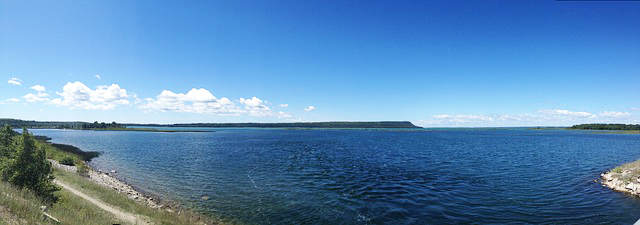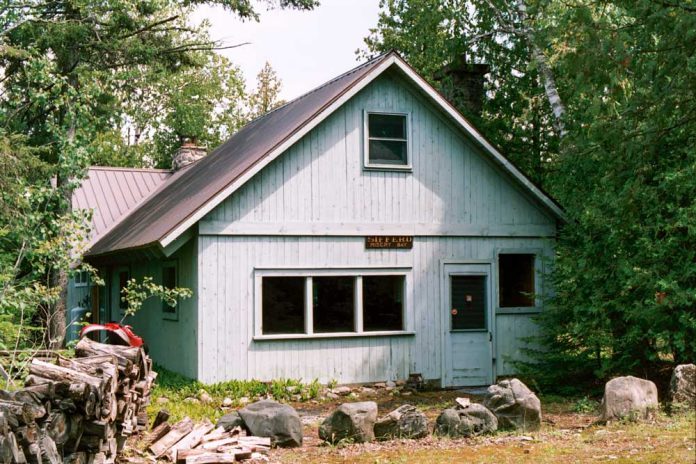MACKINAC—Local and off-Island residents are very concerned with a recent report that shows that a potential oil leak would hit a large portion of Lake Huron, including Manitoulin Island, if Enbridge’s Line 5 ever sustained a leak. Meanwhile, a group of ‘water protectors’ are camping in a location in Northern Michigan, on property owned by a Wiikwemikoong resident, calling for a shutdown of Engbridge’s Line 5 pipeline, and vowing not to move from the camp until that happens.
“We belong to Restore Our Waters International, I am vice-chair,” said Mary Muter, of the Georgian Bay Great Lakes Foundation last Friday, following a report released by State of Michigan agencies on July 19, asking for public comment on a draft independent analysis of the impacts of a potential oil spill from Enbridge Line 5 in the Straits of Mackinac.
“We are terrified what would happen if there is a leak, and the line is right under the bridge on Mackinac,” said Ms. Muter. An oil spill, “would hit areas and shorelines across Lake Huron, it would move right straight across and would hit areas like Lake Huron-Manitoulin Island.”
“It’s almost unthinkable what would happen…it would be horrible,” stated Island resident Mike Wilton of Algonquin Eco-Watch. “Depending on the wind and current, if there were southwest winds if an oil leak occurred it would spread across Lake Huron. There would be a huge amount of the oil hitting the shorelines.”
State of Michigan agencies recently released for public comment a draft independent analysis of the impacts of a potential oil spill from Enbridge Line 5 in the Straits of Mackinac. A team led by Michigan Technological University and directed by professor Guy Meadows of Michigan Tech’s Great Lakes Research Centre submitted the draft report ‘Independent Risk Analysis for the Straits Pipelines’ to state officials on July 16, 2018.
The worst-case approach implemented in the study is based on the accumulation of worst-case assumptions. As a result, the assessment extends to events with low probabilities of occurrence but high consequences.
“According to the analysis of more than 4,300 spill simulations, a rupture to both Straits pipelines with concurrent failures of primary valves on each pipeline and secondary safety valves, could release 32,000 to 58,000 barrels of crude oil into the Great Lakes and impact more than 400 miles of shorelines in Michigan, Wisconsin and Canada based on wind and current conditions. Depending on the timing and magnitude of a spill, 47 wildlife species of concern and 60,000 acres of unique habitat could be at risk,” the report states.
The draft analysis is part of several actions Michigan Governor Rick Snyder has taken aimed at protecting the Great Lakes and other state waterways from a potential Line 5 spill and creating a road map for the line’s replacement with a safer alternative that maintains the important energy and communications infrastructure link between the Upper and Lower Peninsulas.
“Line 5 cannot remain in the Straits in its current form,” said Michigan Department of Natural Resources Director and Pipeline Safety Advisory Board co-chair Keith Creagh, in a release. “This report highlights the need to continue developing a decommissioning strategy that protects the Great Lakes while at the same time maintaining the critical infrastructure between Michigan’s peninsula’s that makes us one state.”
The report notes that “because cultural resources cannot be restored to baseline, their loss must be compensated through compensatory restoration.”
Built in 1953, Line 5 is 645 miles long and transports up to 540,000 barrels a day of light crude oil and natural gas liquids from Superior, Wisconsin, to Sarnia, Ontario. Below the Straits of Mackinac, the pipeline lies on the lake bottom within an easement issued in 1953 by the State of Michigan.
The straits of Mackinac hydraulically link Lakes Michigan and Huron. The channel is 3.5 miles wide and has an average depth of 20 metres. The combined Michigan-Huron system forms the largest lake in the world by surface area and the fourth largest by volume, containing nearly eight percent of the world’s surface freshwater. The Straits of Mackinac serve as a waterway for commercial shipping and are important for recreation, tourism, and fishing. The Straits fall within the 1836 treaty-ceded waters to which several First Nations retain fishing rights.
In a For Love of Water (of which Mr. Wilton is a member) release it is explained, “the next five months are likely to be decisive in the fate of Line 5 at the Straits of Mackinac. We have an unprecedented chance to succeed in shutting down these dangerous 65-year-old pipelines.”
“The consequences of a Line 5 spill are so unthinkable that FLOW is devoting extraordinary efforts to shutting the 65-year-old pipelines down. Before Governor Snyder leaves office at the end of 2018, he is attempting to broker a deal between Enbridge and the state to give the company a new authorization to use the Straits. This time it would be in the form of a tunnel that would take years to build while Line 5 still operates and still leave hundreds of stream and river crossings vulnerable to a spill from Enbridge’s error-prone practices,” the release continues.
The protestors at Camp Anishinaabek, the water protectors, are on property owned by James Pitawanakwat, a member of the Wiikwemkoong Unceded Territory First Nation. He and his wife Christina Keshick of the Saginaw Chippewa Indian Tribe, own the camp properties. He said he and his fellow water protectors are committed to remaining peaceful.
Michigan Radio reported on August 19, 2018 that Mr. Pitawanakwat said the group has no plans of being militant. “This is a prayer camp, a peace camp, and we want people to feel safe, especially if they are defending the water,” he said.





